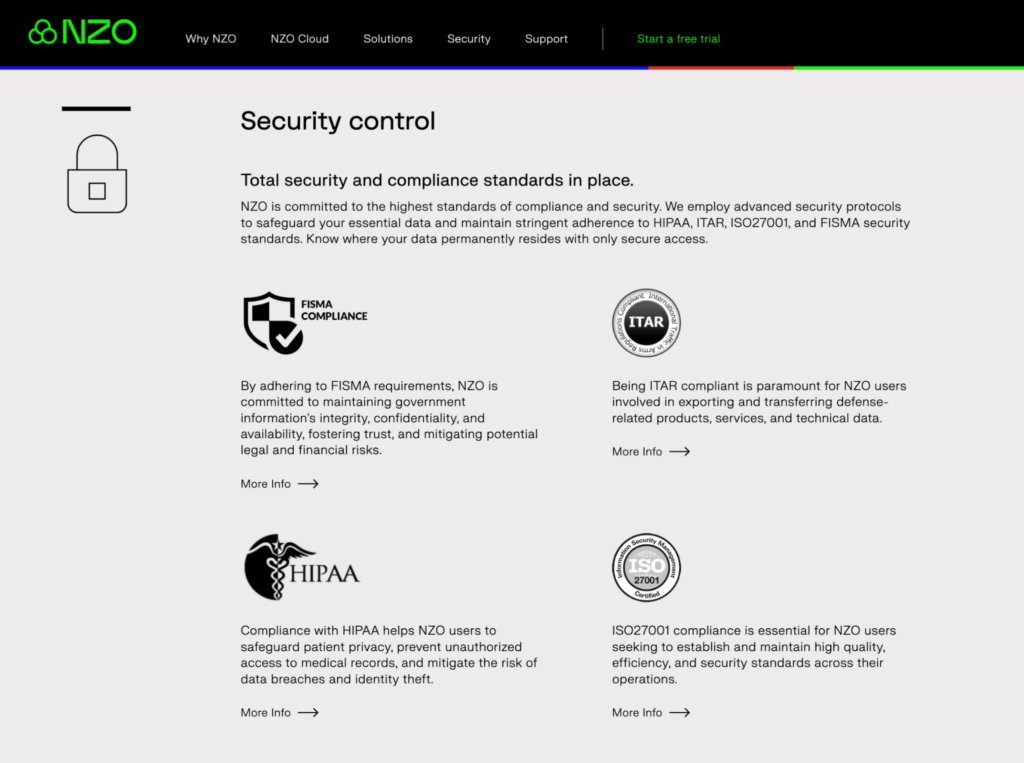Table of Contents

For years, companies in all types of industries have been looking for ways to scale their data sharing and security practices without having to worry about the costs associated with added physical infrastructure. The cloud provides a perfect solution, allowing organizations to securely store, share, and monitor their data in a centralized location while still being accessible on any device.
But, as we remember from the Spiderman comics, with great power comes great responsibility. Since cloud computing has become an integral part of modern IT infrastructure and companies are increasingly adopting cloud services, the need for effective cloud monitoring has become paramount. This article will explore the different types of cloud monitoring, its importance, key components, and the associated challenges and best practices.
What is Cloud Monitoring?
Before delving into the intricacies of cloud monitoring, it is essential to understand what it entails. Cloud monitoring refers to the practice of observing and analyzing the performance, availability, and security of cloud-based resources and services. It involves collecting and analyzing various metrics and logs to ensure the smooth functioning of the cloud environment.
Cloud monitoring services and tools play a crucial role in providing real-time insights into the health and performance of cloud infrastructure. These tools help organizations track key performance indicators (KPIs) such as:
- Response times
- Resource utilization
- Network traffic
By monitoring these metrics, businesses can proactively identify and address issues before they escalate, ensuring optimal performance and user experience.
However, cloud monitoring is not limited to just performance metrics. It also encompasses security monitoring, which involves detecting and responding to potential security threats and vulnerabilities within the cloud environment. This aspect of cloud monitoring is essential for safeguarding sensitive data and ensuring compliance with industry regulations and standards.
Importance of Cloud Monitoring in Modern IT Infrastructure
The prominence of cloud monitoring in modern IT infrastructure cannot be understated. It plays a pivotal role in ensuring the efficient operation of cloud-based systems and services. Here are some reasons why cloud monitoring is crucial:
Ensures Uptime and Reliability of the Cloud Environment
One of the primary objectives of cloud monitoring is to ensure that the cloud environment is always available and functional. By continuously monitoring the infrastructure, applications, and networks, any potential issues can be detected early on, minimizing downtime and ensuring business continuity.
Cloud monitoring also provides organizations with valuable insights into their cloud infrastructure’s overall health and performance. By analyzing historical data and trends, IT teams can identify patterns and make data-driven decisions to optimize their cloud environment.
Aids in Identifying and Resolving Performance Issues
Cloud monitoring helps in identifying and resolving performance bottlenecks that could hinder optimal service delivery. IT teams can proactively address performance issues and optimize the cloud environment by monitoring key metrics such as response times, throughput, and resource utilization.
Helps Ensure Efficient Resource Utilization and Optimization
With cloud computing instances often being deployed in a pay-as-you-go model, efficient resource utilization is paramount. Cloud monitoring enables IT teams to gain insights into resource consumption patterns and make informed decisions regarding scaling, resizing, and load balancing to maximize efficiency and minimize costs.
In addition to performance and security monitoring, cloud monitoring also facilitates capacity planning. By monitoring resource usage and performance metrics, IT teams can accurately forecast future resource needs and ensure that the cloud environment can handle increasing workloads without any performance degradation.
Enables Proactive Security Monitoring and Threat Detection
In an era where data breaches and cyber threats are on the rise, cloud monitoring plays a crucial role in maintaining a secure cloud environment. By monitoring logs, network traffic, and user activities, potential security threats can be identified and addressed proactively, reducing the risk of unauthorized access or data breaches.
Cloud monitoring services and tools often provide real-time alerts and notifications, enabling IT teams to respond promptly to any issues or anomalies. This proactive approach minimizes the impact of potential problems and helps maintain a high level of service availability and customer satisfaction.
Lastly, cloud monitoring plays a crucial role in compliance and regulatory requirements. By monitoring and auditing cloud infrastructure, organizations can ensure that they meet industry-specific standards and maintain data integrity and privacy.
Key Components of Cloud Monitoring

Cloud monitoring encompasses various components that collectively provide comprehensive insight into the cloud environment. These components include:
| Key Component of Cloud Monitoring | Description |
| Infrastructure monitoring | Involves tracking and analyzing both physical and virtual components of a cloud environment, such as servers, storage, and databases, to proactively manage capacity, optimize resources, and preemptively address potential bottlenecks or performance issues. |
| Application monitoring | Not only tracks the performance and availability of cloud-based applications through metrics like response times, error rates, and resource utilization but also analyzes user interactions and behaviors within the application to facilitate data-driven decisions that enhance user experience and optimize performance. |
| Network monitoring | Is vital for ensuring data flows smoothly within the cloud environment, as it not only tracks network traffic, bandwidth utilization, and latency but also analyzes network protocols and identifies potential vulnerabilities to proactively mitigate security threats through the detection of abnormal behavior. |
| Security monitoring | Involves continuous surveillance, including monitoring logs, user activities, and network traffic, to detect and mitigate potential security threats while also implementing robust access control mechanisms and encryption protocols to protect sensitive data, thereby helping organizations stay ahead of cyber threats and safeguard the integrity and confidentiality of their environment. |
| Compliance monitoring | Compliance monitoring in industries with regulatory or compliance requirements is crucial, involving not only the tracking and reporting of compliance-related metrics to ensure adherence to regulatory obligations in the cloud environment but also the implementation and regular auditing of robust policies and procedures to maintain ongoing compliance, identify areas for improvement, and mitigate potential compliance risks. |
1. Infrastructure Monitoring
Infrastructure monitoring involves monitoring the physical and virtual infrastructure components that constitute the cloud environment. It includes tracking metrics related to servers, storage, databases, hypervisors, and other essential infrastructure elements.
When it comes to infrastructure monitoring, it is not just about tracking metrics. It also involves proactive capacity planning and resource optimization. Organizations can make informed decisions about scaling their infrastructure to meet future demands by analyzing historical data and trends. Additionally, infrastructure monitoring can help identify potential bottlenecks or performance issues before they impact the overall system.
2. Application Monitoring
Application monitoring focuses on tracking the performance and availability of cloud-based applications. It involves monitoring metrics such as response times, error rates, and resource utilization to ensure optimal performance and user experience.
Application monitoring goes beyond just tracking response times and error rates. It also involves monitoring user interactions and behavior within the application. By understanding how users navigate through the application and which features they use the most, organizations can make data-driven decisions to improve the user experience and optimize application performance.
3. Network Monitoring
Network monitoring plays a crucial role in ensuring the smooth flow of data within the cloud environment. It involves monitoring network traffic, bandwidth utilization, latency, and other network-related metrics to identify and resolve connectivity issues.
Network monitoring extends beyond monitoring network traffic and bandwidth utilization. It also involves analyzing network protocols and identifying potential vulnerabilities or security risks. Organizations can proactively identify and mitigate potential security threats by monitoring network traffic patterns and detecting abnormal behavior.
4. Security Monitoring
Security monitoring involves continuous surveillance of the cloud environment to detect and mitigate potential security threats. It includes monitoring logs, user activities, and network traffic to identify anomalies, unauthorized access attempts, or suspicious behavior.
Security monitoring is not limited to monitoring logs and network traffic. It also involves implementing robust access control mechanisms and encryption protocols to protect sensitive data. By continuously evaluating and updating security measures, organizations can stay one step ahead of cyber threats and ensure the integrity and confidentiality of their cloud environment.
5. Compliance Monitoring
Monitoring adherence to these standards is crucial in industries with regulatory or compliance requirements. Compliance monitoring involves tracking and reporting compliance-related metrics to ensure that the cloud environment meets regulatory obligations.
Compliance monitoring is not just about tracking metrics to meet regulatory requirements. It also involves implementing robust policies and procedures to ensure ongoing compliance. Organizations can identify improvement areas and mitigate potential compliance risks by regularly auditing and reviewing compliance-related processes.
Public Cloud Monitoring vs Private Cloud Monitoring

Cloud monitoring strategies may vary depending on whether the cloud resources are part of a public or private cloud environment. Public cloud monitoring involves monitoring cloud services provided by third-party vendors, while private cloud monitoring focuses on internal cloud instances managed by an organization. The table below outlines the differences between the two cloud types:
| Public Cloud Monitoring | Private Cloud Monitoring |
|
|
Challenges and Considerations in Cloud Monitoring
While cloud monitoring offers numerous benefits, it also presents certain challenges and considerations. Some of these include:
1. Scalability and Complexity of Cloud Environments
The scalability and complexity of cloud environments make monitoring a daunting task. With numerous cloud instances and interconnected services, monitoring becomes more challenging. It requires robust tools and strategies to effectively monitor the entire cloud infrastructure.
Furthermore, as cloud environments continue to grow and evolve, the dynamic nature of resources and workloads adds another layer of complexity to monitoring. Continuous scalability demands a monitoring solution that seamlessly adapts and scales alongside the cloud infrastructure.
2. Data Privacy and Compliance Requirements

Data privacy and compliance play a crucial role in cloud monitoring services. Organizations must ensure that sensitive data is adequately protected and that monitoring practices comply with applicable regulations such as GDPR or HIPAA.
In addition to regulatory compliance, organizations must also consider the geographical location of data and the implications for monitoring. Data sovereignty laws may dictate where data can be stored and processed, impacting the design and implementation of cloud monitoring solutions.
3. Integration With Existing Monitoring Systems
Integrating cloud monitoring with existing monitoring systems can be complex. The seamless flow of data between various monitoring tools and systems is essential to ensure a holistic view of the entire IT infrastructure.
However, compatibility issues between different monitoring tools and platforms can hinder the integration process. Organizations need to invest time in evaluating and testing integrations to guarantee that data flows smoothly and that alerts and notifications are synchronized across all monitoring systems.
4. Handling of False Positives and Alert Fatigue
The high volume of alerts generated by monitoring tools can lead to alert fatigue, where critical alerts may be overlooked due to an overwhelming number of false positives. Organizations need to fine-tune their monitoring parameters and alert thresholds to ensure that alerts are actionable and relevant. This involves continuous review and adjustment of alerting mechanisms to minimize noise and enhance the accuracy of notifications.
5. Multi-Cloud and Hybrid Environments
Managing monitoring across multi-cloud and hybrid environments adds an additional layer of complexity. Ensuring consistent monitoring and visibility across different cloud providers and on-premises infrastructure can be challenging. Organizations must adopt compatible monitoring tools and practices across diverse environments to maintain a unified management strategy.
6. Security Threat Detection and Response
As cloud environments are dynamic and expansive, they can be vulnerable to security threats requiring sophisticated monitoring. Implementing advanced security monitoring tools that include features like anomaly detection, real-time threat intelligence, and automated incident response is crucial for maintaining cloud security.
7. Technical Expertise and Training
The effectiveness of cloud monitoring often depends on the technical expertise available within an organization. As cloud technologies evolve, there is a continuous need for up-to-date training and knowledge. Organizations need to invest in ongoing education and training programs for IT staff to keep up with the latest cloud monitoring tools, practices, and technologies to ensure effective deployment and maintenance of monitoring systems.
Cost Considerations and Budgeting for Monitoring Tools
Implementing effective cloud monitoring requires investment in appropriate tools and resources. Organizations need to consider budget allocation for monitoring tools, training, and ongoing maintenance costs to ensure a robust and reliable monitoring strategy.
Cost considerations extend beyond the initial setup phase. Organizations must account for potential scalability costs as their cloud environment grows, as well as any additional features or modules that may be required to enhance monitoring capabilities over time. A comprehensive cost-benefit analysis is essential to optimize the monitoring investment and maximize the value derived from the cloud infrastructure.
With many cloud monitoring service providers, determining monthly costs with variable pay-per-use fees can be difficult. Some common reasons why cloud costs quickly skyrocket out of control include:
- Unused or underutilized EC2 instances in AWS
- Unneeded orphaned snapshots
- Unattached or unused EBS volumes
- Underutilizing reserved instances
- General data transfer costs (especially for data transfer outside of your region)
- Unused elastic IP (EIP) addresses
- Unused elastic load balancers (ELBs)
With NZO Cloud, the potential for your company to go over budget with cloud costs is eliminated through an easy-to-understand monthly subscription that is flexible, scalable, and performance-focused. Speak with NZO to learn more.
Best Practices for Cloud Monitoring
Effective cloud monitoring is essential for ensuring cloud services’ performance, security, and reliability. By implementing a systematic approach to monitoring, organizations can detect and respond to issues promptly, optimize resources, and maintain compliance with industry standards. Here are some best practices to follow:
Define Clear Monitoring Objectives and KPIs
The first step in effective cloud monitoring is to define clear objectives and key performance indicators (KPIs). These objectives should align with your business goals and the specific requirements of your IT infrastructure. Common KPIs for cloud monitoring include system uptime, response time, error rates, and resource utilization rates. By establishing what metrics are most critical, you can tailor your monitoring strategy to focus on what matters most, ensuring that your team knows what to look for and why it’s important.
Implement Comprehensive Monitoring Across All Layers
Cloud environments are complex and multi-layered, encompassing everything from physical hardware and network infrastructure to applications and data. Effective cloud monitoring requires a comprehensive approach that covers all these layers. This includes:
- Infrastructure monitoring: Track the health and performance of physical servers, VMs, and other hardware.
- Network monitoring: Monitor bandwidth usage, latency, and packet loss to ensure data flows efficiently across your network.
- Application monitoring: Keep an eye on software and applications to detect issues that could affect performance or user experience.
- Security monitoring: Implement security-specific monitoring to detect and respond to threats in real time.
By monitoring across all layers, you can gain a holistic view of your environment, making identifying the root cause of issues easier.
Establish Alerting and Notification Mechanisms
To respond quickly to potential issues, it’s critical to have effective alerting and notification mechanisms in place. These systems should be capable of analyzing and monitoring data in real time and sending alerts when anomalies are detected. It’s important to configure these alerts properly to balance between being informative and overwhelming; too many notifications can lead to alert fatigue, where critical alerts might be overlooked. Tailor alert thresholds to match the severity of issues and ensure that alerts are sent to the appropriate personnel.
Regularly Review and Analyze Monitoring Data
Collecting data is only part of the equation; regularly reviewing and analyzing this data is crucial for gaining insights into the performance and health of your cloud environment. This analysis can help identify trends, predict potential problems before they occur, and inform business decisions. It’s also essential for compliance purposes, as historical data can demonstrate adherence to regulatory requirements.
Continuously Optimize Monitoring Configurations
Cloud environments are dynamic, with changes and updates occurring regularly. As such, it’s important to continuously review and adjust your monitoring configurations to keep pace with these changes. This might involve updating what metrics are monitored, recalibrating thresholds for alerts, or adopting new tools and technologies that can provide deeper insights. Regular audits of your monitoring strategy and tools will help ensure they remain effective and aligned with your current needs.
By following these best practices, organizations can ensure they are effectively monitoring their cloud environments, leading to improved performance, enhanced security, and better alignment with business objectives. Effective monitoring is not a one-time setup but a continuous process of improvement and adaptation to new technologies and changing business needs.
Conclusion
cloud monitoring is an indispensable component of modern IT infrastructure, providing the insights needed to maintain optimal performance, enhance security, and ensure reliability in the cloud. As cloud adoption continues to rise, the importance of a robust cloud monitoring strategy cannot be overstated. Organizations can effectively manage their cloud environments by understanding the types, challenges, and best practices of cloud monitoring discussed in this article.
This includes setting clear monitoring goals, covering all aspects of the cloud, establishing effective alert systems, regularly reviewing data, and continually optimizing monitoring setups to adapt to new challenges and opportunities. Ultimately, proactive cloud monitoring prevents potential issues and supports strategic decision-making, ensuring that cloud resources align with business objectives and compliance requirements.
Discover how NZO Cloud can help you make cloud monitoring easier and more effective by starting a free trial today.




